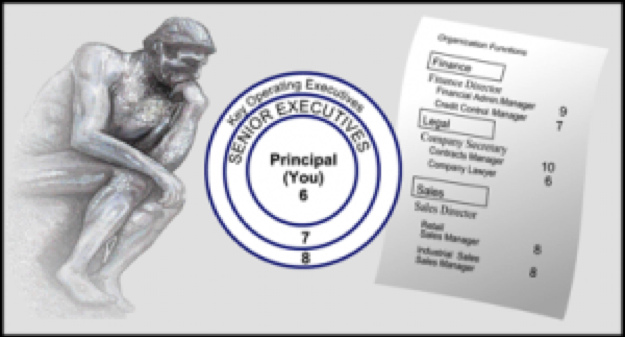Welcome to ALL THINGS BUSINESS Blogs
What does the hierarchy of Knowledge look like in your company
Many people at top management level are afraid to admit that they do not know the answer. As a result, they make decisions when they are not in the best position to do so. It follows that many of those decisions create unsuccessful outcomes - as well as frustration for those that did know the Answer and were not asked.
Those who profess to know everything will inevitably proceed to do or control everything, frustrating all of those around them. They demonstrate a key difference between being a Boss or a Leader
‘I will do it myself’, ‘I’m the only one I can trust’, ‘I need to oversee/control everything’ are common beliefs of the Boss who is then surprised when employees show a lack of ownership.
But employees working for this sort of boss might be forgiven for thinking, ‘Why should I take ownership of problems which were created by your lack of management skills?’
As you climb a structured ladder to a position in which others report to you, you will have to change your approach. You will need to move away from doing and become more of a facilitator, coordinator, Coach and motivator.
I developed the following model to help me show a group of directors where I felt they were getting it wrong in controlling too tightly their teams. I wanted to visually demonstrate that their view of themselves as the only custodians to Knowledge in the company was the wrong way around and as a result they were not getting the best out of their teams.
I wanted them to understand that they did not, and did not need, to know everything. I call it the Circle of Knowledge. Their results were a reverse of what is demonstrated below.
Try it out yourself. For the sake of the example, the assumption is that your company has a Principal (you), with three Senior Executives. Each executive has some key operating executives reporting to him or her.
The first step is to draw a circle and put your name in the circle. Then on a Separate piece of paper, list the functions that you have under you.
Your list will look something like this
Principle Circle
The next step is to establish a rating for your own knowledge base of the main functions of your company. Give yourself marks out of ten for your knowledge of each of these functions.
For example, when scoring yourself you may consider that you are quite knowledgeable about sales and award yourself 8 out of 10. For finance you may score 6 and for legal knowledge you may give yourself 4 points. Follow the process through and calculate your average score. Write this average score in the circle with your name and position.
The picture now looks something like this:
The Principles Score
Now, draw another circle around the first one and write ‘Senior Executives’ in it.
On a separate piece of paper write the separate functions that each of your Senior Executives covers. For example, sales might cover retail, industrial and so on.
Now mark the Senior Executives on each of their functions. I know this is subjective but believe me it really does have an impact. By way of example, the Sales Director may have a retail background so might score 9 on retail but may score only 4 on another area of responsibility. Make sure you cover all areas of responsibility. Average these scores.
When you have marked each Senior Executive take the average score of each Executive and create an average of the averages. Put the number in the circle with ‘Senior Executives’ on it.
The emerging picture would look something like this:
Senior Executives score
Follow the same process for your Key Operating Executives.
Again, take their subsections to mark against. Management accounts, for example, might consist of monthly accounts, asset management, auditing and so on.
Having marked each subsection and averaged the scores, calculate the overall average score for your Key Operating Executives. Then, draw a circle, outside the ‘Senior Executives’ circle, showing this average score.
Your result will be something like this.
Key Operating Executives score
I completed this exercise at the beginning and end (above) of implementing my Thinking Organizational program.
I scored 7 as a Principal. My Senior Executives scored 8 and my Key Operating Executives 9.
I did not go all the way down and mark every member of staff, but I will bet they would have got 10’s - because at the bottom of an organization, the requirement for an employee to be a specialist in a single subject is likely to be greater. For a start, they do not have others reporting to them, so their jobs do not encompass a requirement to directly manage people.
If you compare this to a company run by a ‘know it all’ leader, you will see that there will be a fundamental difference in the way they are run.
The Circle above showed that both its specialist knowledge base and its generalist knowledge base were located where they needed to be. If the balance is reversed the company will be totally driven from the top, not only strategically, which is correct, but also in day-to-day running. This seriously impedes progress in two ways:
1. It is impossible for one person to be an expert in every area.
2.The sheer amount of time spent doing the work and making decisions for everyone, reduces quality thinking time to practically nil.
As a result, not only is there no time to think about the future, but empowerment is hindered on a day-to-day basis.
If those at the top of organizations give out the message that they are the only ones capable of making any decisions no matter how small, they will create a situation of disengagement.
Those who should be making decisions do not bother because they know that the person at the top will take over. Equally, the person at the top walks around saying ‘The only one who will make a decision around here is me’. The Circle of Knowledge methodology can be used at any organizational level. For example, a manager could place ‘Manager’ in the middle of the circle and use the outer circles for ‘supervisor’ or ‘assistant’ and so on. You can even use the system if, like many, you employ temporary staff or when assessing the value of outsourcing.
As a Principal, you are not needed as the boss anymore, except in extreme emergencies or when asked for help form your team.
Today your role is to lead people which means you are now more conductor than violinist
Feedback is always welcome so leave a comment or email me at rikki@thinking.co.uk You can also visit my site www.Thinking.co.uk.






